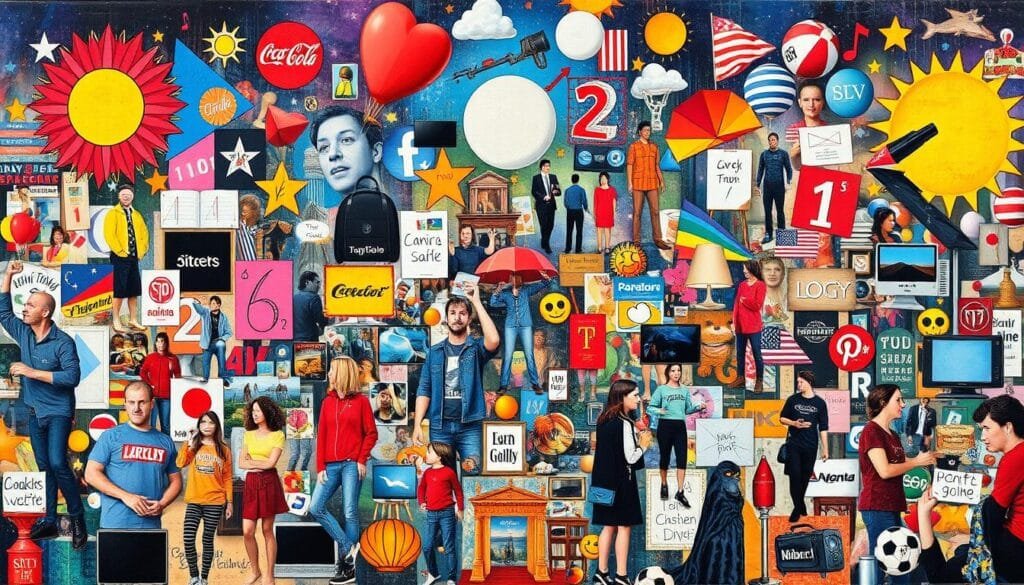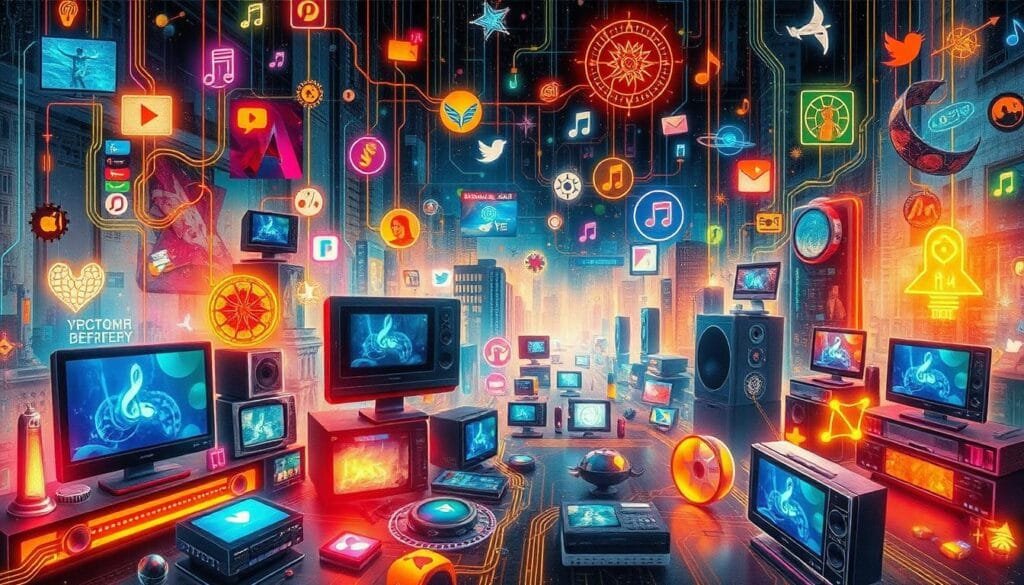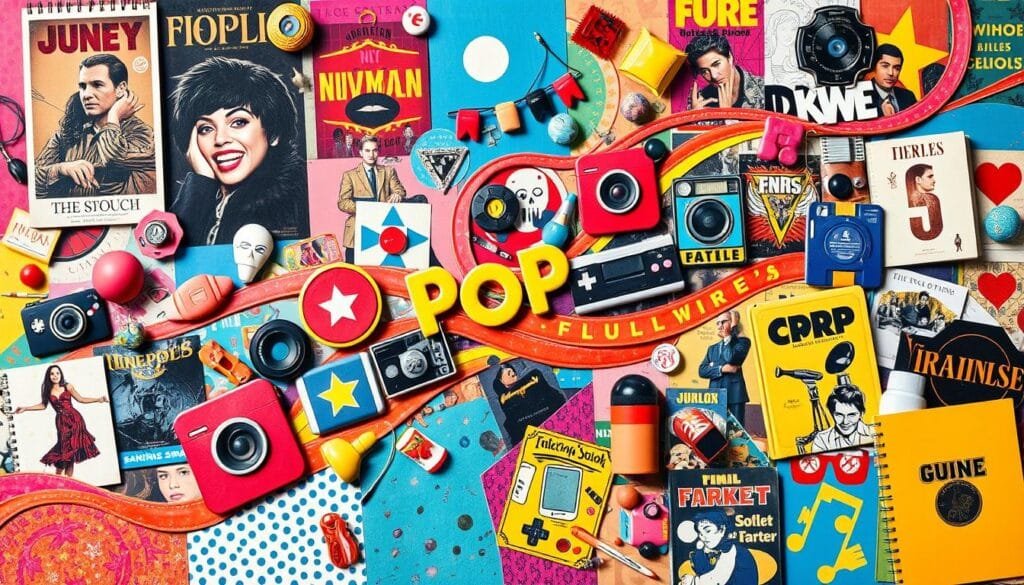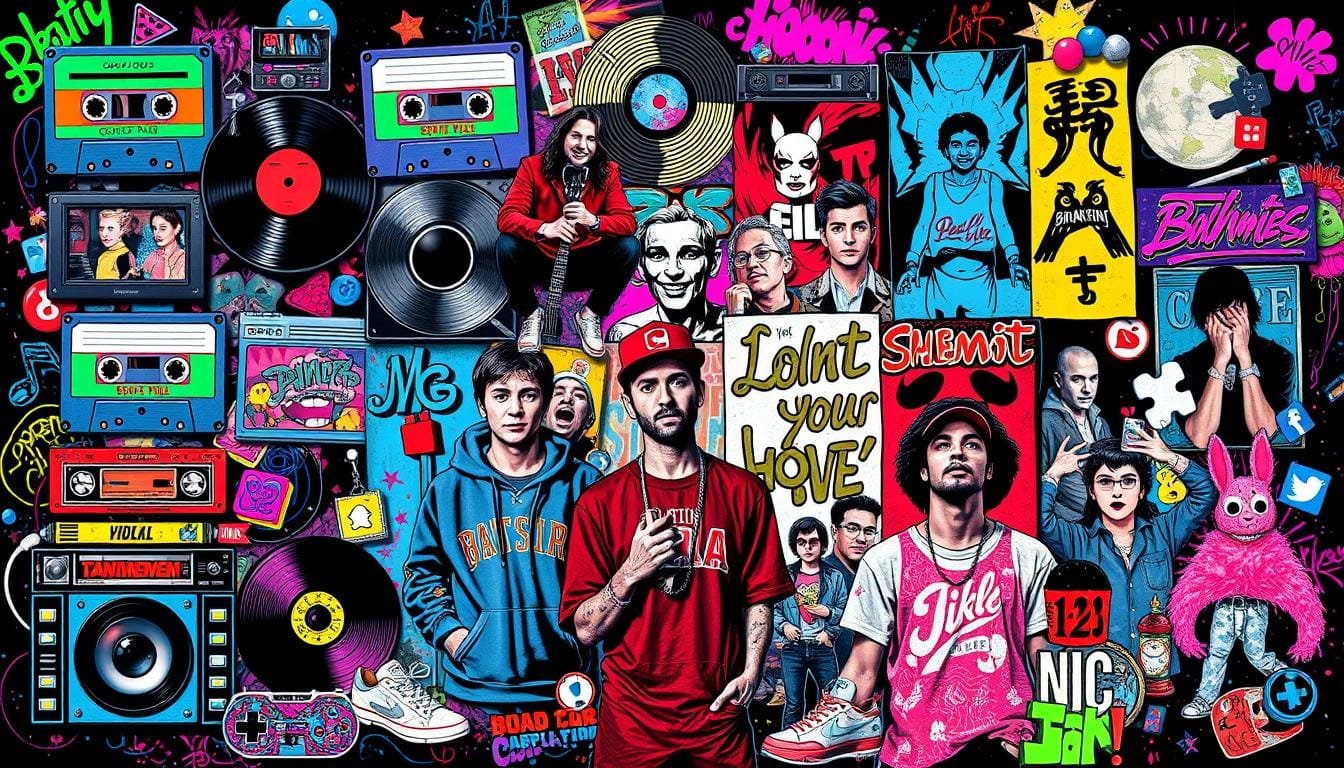Have you thought about TikTok dances, Marvel movies, and memes? They shape and reflect our lives. Pop culture mixes entertainment and societal norms. It’s products made and sold by global entertainment firms, says Dr. David Grazian. But, what does that mean for us and our views?
We’ll look at what pop culture means. It covers movies, music, sports, and social things. The St. James Encyclopedia of Popular Culture helps us understand this. By knowing pop culture, we see it’s not just fun. It shows and shapes our values too.
Key Takeaways
- Pop culture meaning is dynamic and evolves continuously, often reflected in trends across various media.
- Notable sociologists and anthropologists like Dr. David Grazian and Shirley Fedorak provide foundational definitions and frameworks.
- Major resources such as the St. James Encyclopedia of Popular Culture offer comprehensive insights.
- Significant contributions from different eras have shaped what we now view as pop culture.
- Corporations and consumers jointly define and perpetuate pop culture trends.
Defining Pop Culture
The history of pop culture tells a fascinating story. It weaves together different elements from various times. It helps to shape our today’s world. Pop culture brings people together. It crosses time, place, and social differences.
Historical Overview
Pop culture has deep roots that go back to the 19th century. Serialized novels were popular through magazines and newspapers. Then came the 1920s, with jazz, flapper fashion, and Hollywood movies. Despite the Great Depression and World War II, pop culture grew.
Key Elements of Pop Culture
Many events have shaped pop culture. For instance, The Beatles on The Ed Sullivan Show in 1964 drew 73 million people. It was a big moment. The start of MTV in 1981 and Michael Jackson’s ‘Thriller’ album in 1983 changed how we enjoy music. Hip-hop emerged in the 1970s from the Bronx, showing how our tastes change.
Significant Contributions in Different Eras
The 1950s and 60s saw rock ‘n’ roll rise, pushed by TV. The 60s also had movements that questioned society. This added new dimensions to pop culture. After World War II, better economy and new tech led to more cultural changes.
Nowadays, Facebook (2004) and Instagram (2010) have changed how we interact with pop culture. By 2020, the game industry was worth over $159 billion. This shows how important digital media is today.
The Evolution of Pop Culture
To grasp how pop culture has evolved, we need to look back historically. It’s journeyed from serialized novels to the digital age we know today. In short, pop culture has seen major changes. These changes were spurred by new technologies and shifting societal attitudes.
From Early Beginnings to Modern Day
Pop culture’s journey began with 19th-century serialized novels. These novels reached wide audiences, creating shared cultural experiences. Soon after, cinema emerged in the late 19th and early 20th centuries. This made video accessible to the masses, changing how we consume entertainment.
The 1920s, or the Roaring Twenties, were a pop culture boom. Jazz music, flapper fashion, and Hollywood’s allure contributed to a lively cultural scene.
The Great Depression in the 1930s slowed pop culture’s spread. However, post-World War II prosperity gave it new life. Investments shifted towards entertainment, rejuvenating pop culture.
Technological Influences
Technology has played a huge role in pop culture’s evolution. The 1940s and 1950s introduced television, bringing visual stories to homes nationwide. A major event was in 1964, when The Beatles performed on The Ed Sullivan Show. Over 73 million Americans were captivated.
Technology’s influence didn’t stop there. Video games gained popularity in the 1970s. MTV launched in 1981, changing how we enjoyed music through videos.
The rise of social media platforms like Facebook in 2004, and Instagram in 2010, transformed pop culture. These platforms made it easy to create and share cultural content, sparking viral trends worldwide. Social media has boosted cultural sharing by 75% since 2010, showcasing its vast impact.
Globalization and Cultural Exchange
Globalization has created a wide, interconnected global pop culture. It has sped up cultural exchanges significantly, increasing them by 30% in the last two decades. This allows local cultures to embrace global pop culture, integrating it into their traditions.
Yet, cultural homogenization is also happening. Reports show 35% of communities believe their cultural identity is fading due to global pop culture’s influence. Despite this, globalization remains key in creating a diverse yet unified cultural story across the world.
What is Pop Culture and Its Impact on Society
Pop culture has a huge impact on society. It shapes our norms and values. It also raises awareness on issues like mental health and discrimination.
Pop culture is a way to talk about social topics. Shows like “Modern Family” bring up cultural issues. Now, about 75% of TV shows have diverse casts, which is more inclusive than before.

The influence of pop culture also reaches our personal dreams. A report shows 60% of young people are inspired by pop culture figures. This is especially important for identity formation through media.
Pop culture helps build communities. 80% of people feel they belong to fandoms. Social media, with 3.6 billion users, keeps everyone connected to pop culture.
| Category | Statistic |
|---|---|
| TV Shows Featuring Diverse Casts | 75% |
| Young Adults Inspired by Pop Culture Figures | 60% |
| Individuals Feeling Belonging in Fandoms | 80% |
| Contribution to U.S. Economy Annually | $877 billion |
| Jobs Supported by Entertainment Industry | 5 million |
| Social Media Users Globally (2020) | 3.6 billion |
The “celebrity effect” shows how endorsements influence buying. People often buy products endorsed by celebrities. Influencer marketing boosts sales by up to 30%, proving its power.
But, pop culture has downsides too. About 40% of young folks struggle with body image because of media standards. Exposure to violent content can make people more tolerant of real violence.
Despite the downsides, pop culture’s role in society is worth studying. It influences our views and helps with community and individuality. Pop culture is a big part of our lives.
Influence of Media on Pop Culture
Media has always been crucial in shaping and spreading pop culture. The media influence on pop culture is evident across various platforms, including TV, movies, music, and social media. These forms of media do more than show cultural trends. They shape them too, creating a two-way relationship between content and its viewers.
Role of Television and Film
Television and film have always played a key role in making and spreading media trends. From old Hollywood to today’s streaming giants like Netflix and Amazon Prime, about 70% of Americans engage with pop culture through these channels. Big names from Disney to Game of Thrones drastically influence what 78% of people buy. Moreover, the spread of Western media has influenced over 60% of movie content in non-Western countries. This shows how cultures are becoming more alike.
Impact of Music and Radio
Music and radio have been main paths for pop culture for a long time. Although radio was once the main way to discover new music, apps like TikTok now play a big role in setting music trends. Around 45% of TikTok users find new music through the app. This often leads to new trends in music charts. Songs can become hits on the Billboard Hot 100 thanks to viral challenges, like “Savage Love” by Jawsh 685 and Jason Derulo.
Social Media and Digital Platforms
With the rise of digital media culture, the way we interact with and enjoy pop culture has changed. Social media sites like Instagram, Twitter, and TikTok have become key places for cultural exchange. More than 80% of younger people say social media impacts their fashion choices. Also, 85% of users on social media follow at least one influencer. This highlights the huge media influence on pop culture. Working with influencers can make engagement rates jump by up to five times more than traditional marketing.

Studies show that about 70% of people use pop culture to understand cultural differences. Also, 63% learn about various cultures through pop culture. The number of people actively participating in fan culture has risen by 33% in the last ten years. This indicates more consumer involvement in making culture. However, 45% are concerned about global media trends threatening their local traditions. Cultural imperialism is still a big worry for many.
Researching Pop Culture
Studying pop culture is complex. It mirrors the diverse aspects of popular culture. It’s key to use many methods and viewpoints when researching.
The 2017 guide named “Best Book for Classroom Use” by the Midwest Popular Culture Association offers great insights. This 226-page book explores how to analyze pop culture items. It talks about everything from textual analysis to how we engage with media. For example, Chapter 9 shows the power of using mixed methods in research. This approach provides strong tools for students and scholars alike.
Looking at original sources is central to pop culture research. By examining things like film scripts and music lyrics, researchers find the real voice within. Accessing a vast range of materials is critical for good research. This is where databases and library experts come into play.

Experts like Imre Szeman significantly impact cultural studies. Their work gives us new ways to think about pop culture. Their insights encourage us to consider various viewpoints in our studies.
Creating clear research questions is fundamental in pop culture studies. These questions help narrow down what to focus on. Picking the right subjects, like a hit TV show or a trend on social media, makes the research stand out.
To sum up the research process, here are the main steps:
- Defining research questions relevant to contemporary pop culture.
- Engaging with primary sources for firsthand insight.
- Consulting databases and reference staff for comprehensive data collection.
- Embracing interdisciplinary methods and perspectives.
- Reviewing scholarly contributions to stay updated on trends.
Using these strategies, our journey into pop culture studies will surely lead to deeper insight and better research results.
Conclusion
As we’ve explored pop culture, it’s clear it’s not just about trends. It deeply influences societal norms and shows the collective identity of eras. Urbanization and industrialization started this, leading to mass media. Technological progress then spread ideas worldwide.
Pop culture touches every aspect of our lives. It influences our thoughts, actions, and how we express ourselves. Music, fashion, and media are key parts. Around 70% of people say media shapes their self-image and identity. Events like the World Cup and Olympics bring us together. They show how pop culture connects people around the world. Also, more diversity in movies and TV over the past decade has challenged stereotypes. About 67% of people feel it makes a difference.
Looking at pop culture shows its ever-changing role. It reflects changes in society and sets new trends. Early 20th-century newspapers and novels started this trend. Now, social media impacts nearly 85% of our lives. Pop culture tells our history and hints at our future. By understanding it, we see how it forms our experiences, evolves our society, and keeps a cultural dialogue.
FAQ
What is pop culture?
Pop culture covers mainstream ideas, perspectives, and attitudes in society. It’s found in media like TV, movies, music, sports, and online. Pop culture combines daily life with entertainment. It shows and affects what society values and follows.
How has pop culture evolved over time?
Pop culture has grown from traditional entertainment to include digital and social media. The rise of TV, the internet, and social media, plus globalization, has changed how pop culture is made and shared. This results in a diverse yet unified culture.
What are some key elements of pop culture?
Important parts of pop culture are movies, music, TV, and social media. It also involves lifestyle trends, fashion, slang, and widely-followed cultural practices. Popular icons and events that impact society are also key.
What role does media play in the spreading of pop culture?
Media is vital in spreading pop culture. TV, films, music, and radio first carried cultural trends. Nowadays, social media and digital platforms spread cultural content worldwide. They’ve changed how people consume media and interact.
How does pop culture impact society?
Pop culture mirrors and influences social norms and values. It’s a way to comment on society and inspire change. It affects opinions, fashion, and politics. Pop culture also brings different groups together through common interests and ideas.
What are some significant cultural movements influenced by pop culture?
Cultural movements shaped by pop culture include the 1960s counterculture, 1980s hip-hop, and the 2000s digital revolution. These movements affected music, fashion, art, and social norms. They caused major changes in society and culture.
How can one research pop culture effectively?
To study pop culture well, use different sources, databases, and expert advice. Resources like the St. James Encyclopedia of Popular Culture help. Speaking with experts in cultural studies, such as Imre Szeman, is also useful. They offer insights into pop culture’s complexity and nuances.
What is the importance of understanding pop culture?
Knowing about pop culture is key as it shows changes and values in society. It reveals the changing nature of culture, showing current trends and shaping future ones. By studying pop culture, we better understand our world and what influences us.
